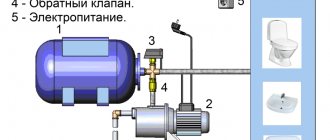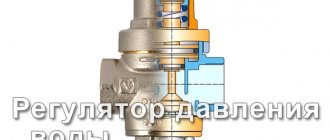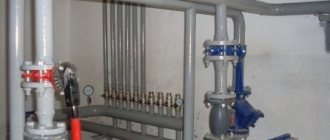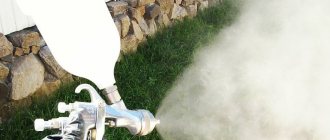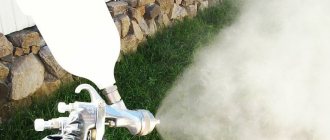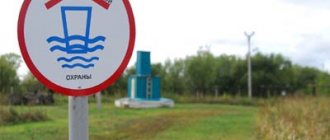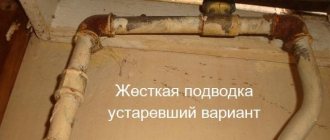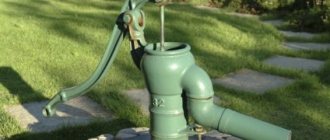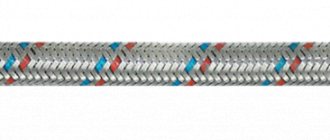Modern life cannot be imagined without running water in an apartment. Water supply is a complex and multifunctional process, the operation of which for normal human life must be provided around the clock and with the required pressure. Although the latter can often cause problems.
In this material we will look at what standards exist for water pressure in the water supply in an apartment and what can be done if the prescribed standards are not met. This information will be useful to consumers of water supply services in an apartment building.
We will supplement the presented material with visual photographs and video tips on installing equipment that allows you to increase the pressure in the water supply.
Units
First, let’s find out what specific units of measurement of water pressure in a water supply system are currently used.
Atmosphere
This unit corresponds to atmospheric pressure at sea level. Here, however, there is a small subtlety: we are talking about fairly atmospheric excess pressure. Its value in the water supply of 0.2 atmospheres, demonstrated by the pressure gauge, corresponds to the full value of 1.2 atmospheres.
Useful: instead of the word “atmosphere”, an equivalent concept is often used - kgf/cm2. The physical essence of the unit is the hardening with which a mass of 1 kg under the earth’s acceleration of gravity will press on an area of 1 cm2.
Bar
An outdated unit of measurement, borrowed from the GHS measurement system used before SI. It is enough to know about it that the bar is approximately (with an accuracy of about 2%) equal to the atmosphere. Often, a pressure gauge for measuring water pressure in a water supply system has two scales - in bars and megapascals.
Megapascal
Pascal corresponds to one newton per square meter of surface. Because a mass of one kilogram presses on the base with a force of 9.8 newtons, 1 megapascal approximately corresponds to 9.8 kgf/cm2. From time to time this value is rounded to 10.
Pressure
The concept of pressure, measured in meters, refers to the height of the water column corresponding to a certain excess pressure. How to determine the pressure with known pressure gauge readings in kgf/cm2? There are enough of them for 10: one excess atmosphere can raise the water column by 10 meters.
What is it measured in?
Before starting work, you need to figure out what and in what measurement system you will have to work.
From school, everyone knows that in physics, pressure is the force with which a substance acts on the walls of a vessel. It also says that in SI it corresponds to pascals (Pa) or newtons per square meter (N/m2). On the scale of equipment for measuring water pressure you can find the following symbols:
Pa, Pa, KPa, MPa . Pascal is a measure of pressure accepted in the international system of units.- Kgs/cm2, kgf/cm2 . The kilogram-force per square centimeter is an obsolete unit.
- Ata, atm . Technical atmosphere. 1 ata = 1 kgf/cm2.
- mm water Art., mm H2O . Millimeter of water column.
- Psi, psia, psig, lb/in2 . Pounds per square inch. Found on American and European devices.
- Bar, bar . A value approximately equal to one technical atmosphere.
In SNiP 2.04.02-84, pressure is given in megapascals (MPa). The normal water pressure value is also established there.
Pressure is the mechanical energy of flow over an area. Measured in meters. Acceptable values for residential areas are indicated in SNiP 2.04.01-85.
Standards
In the Russian Federation, the sources of normal pressure values in the water supply system are the following regulations:
- Decree of the Government of the Russian Federation dated May 6, 2011 No. 354, Appendix 1;
- Code of Practice 30.13330.2016;
- SNiP 31-01-2003;
- SNiP 2.04.02-84;
- SNiP 2.04.01-85.
It is worth noting that the indications for cold (CW) water supply differ from hot (DHW). At high temperatures, pressure can change quickly.
For stable operation of the distribution system, hot water is supplied at lower pressure.
The standard establishes:
- DHW = 0.03 – 0.45 MPa or 0.3 – 4.5 atmospheres;
- Cold water = 0.03 – 0.6 MPa or 0.3 – 6 atmospheres.
If the indicators do not correspond to those indicated above, then you can safely request a recalculation from the service provider.
Even small deviations from the norm can be a reason to contact the relevant authorities . You should not overpay for services that were provided with obvious violations. You can find out the exact data using pressure gauges.
Pressure in public and private pipelines
According to GOST, the pressure in the water supply network should be 4 bar
Optimizing pressure in a city water supply is impossible; in addition, accurate information about the pressure force is not currently provided. If the line complies with the established GOST, the pressure will be 4 bar. However, this figure often drops to 2.5-2.7 bar. Therefore, water consumption can be minimal.
In a private (autonomous) water supply system, the water pressure is calculated individually. This depends on the type of plumbing fixtures chosen, as well as the resistance indicator when the resource passes through the pipes from the source. The selected pumping equipment plays a huge role. The optimal indicator in the private sector is a pressure of 1.5-2 bar. You can check this with a pressure gauge.
Permissible pressure in the water supply system according to the standard
The water supply system is an engineering communication, the presence of which provides us with a comfortable existence if the main standard parameter is met - the water pressure in the water supply in the apartment. The pressure in the network affects the service life of the entire system and household appliances connected to this network.
Standard indicators of pressure in the water supply system
The apartment parameters will comply with GOST 356-80 only if the network hydraulics are brought to the standard. Such indicators are calculated when installing a cold water supply system according to SNiP 2.04.02-84. The main factors in this regard are the following data:
- Number of floors and height of the building.
- Number of people living.
- List and quantity of water fittings.
The minimum pressure is taken to be one bar or 1.0197 atm. With this indicator, the water moves by gravity, and the consumer does not have the opportunity, even on the second floor of a multi-story building, to simultaneously use several water intake taps.
The maximum permissible pressure value in the city network can reach 15 atmospheres according to GOST 356-80. But with this indicator, massive network accidents are guaranteed. Modern shut-off valves are not able to withstand such loads. Therefore, in reality, the pressure in the water supply network is limited to 6-7 atmospheres.
Thus, with a minimum hydraulic value, the consumer will not be able to fully use water, and with a maximum, accidents and breakdowns of plumbing fixtures are guaranteed.
Optimal pressure indicators
To overcome the situation, optimal indicators of network parameters have been developed. The basis for calculating optimal hydraulics is the rate of fluid consumption per person. According to SNiP, each resident uses approximately 4.5 m3 of water per month.
Having carried out calculations that take into account the throughput of intra-apartment pipes, the optimal value for a five-story apartment building was determined to be 2.5 - 4.0 atmospheres.
When designing high-rise residential buildings, a house pumping station is simultaneously calculated, the task of which is to bring water to people from the upper floors. To do this, a pressure pump with the necessary piping and automation is installed.
Household appliances are designed specifically for this indicator. For full operation of an automatic washing machine and dishwasher, 2 atmospheres are enough, and for a shower cabin with a massage function – 4 atmospheres. In the case of installing autonomous heating for the boiler, the optimal pressure is 1.5 - 2.5 atmospheres.
How to correctly calculate the physical parameters for an apartment building
According to the SNiP reference book, the minimum pressure at the inlet of the first floor is 1 bar, which allows you to create a column of cold water of 10 meters. Then for each floor it should be increased by the height of this floor, that is, by an average of 4 meters, which is equal to 0.4 bar. And so the calculation is used for each floor.
By calculation it is clear that with a number of floors above the 5th floor, the city network pressure will be insufficient. And in this case, auxiliary equipment is needed to normalize the indicator. A pump installed individually in an apartment will not produce results. It will be able to increase the pressure to a maximum of 1.5 atmospheres, which is still not enough for comfortable living.
It is also important to know that Decree No. 307 of the Government of the Russian Federation fixed these indicators at the point of disassembling an apartment at the level of 0.3-4.5 atmospheres for hot water supply and 0.3 - 6.0 for a cold network
Ways to change water pressure
If the network pressure still exceeds the optimal value and plumbing equipment and household appliances suffer from this, a compensator is installed, adjusted to discharge the excess volume of liquid into the sewer. Such cases are very rare. Compensators are used - valves on street water supply systems in the event of mass complaints from the population of a certain group of houses about exceeding the standard in the network.
Cases of insufficient pressure are more common. And regulating the indicator to the optimal value is the immediate task of public utilities.
Methods of taking readings
Theoretical knowledge of standard values relating to water pressure allows us to move on to practice, which gives an answer to the question of how to measure water pressure at home in a tap or other water points in an apartment.
Method #1 - using stationary pressure gauges
The main device for measuring pressure in water supply lines is a pressure gauge. There are several types of devices for this purpose, differing in design and operating principle.
The most common type of water pressure reading device is a mechanical pressure gauge. It is reliable in operation, has an easy to read scale of values and an information dial
Often, monitoring the water pressure in an apartment is limited to the readings of a device installed at the boundary separating the intra-apartment and central pipelines. However, in reality, the readings of such a pressure gauge will not be entirely correct and will be accepted with some errors.
This is due to the fact that all pressure losses on the elements of the apartment’s internal wiring (filters, tees, shut-off and control valves) are not taken into account. In addition, the free water pressure is affected by turns and sections with changes in pipeline cross-sections.
Therefore, the best option is to equip all entrances to water consumption points in the apartment with pressure gauges. This is quite accessible at the stages of housing construction or during repair work to replace water supply pipelines.
The absence of permanently installed devices does not deprive the consumer of the opportunity to measure water pressure at any water point by other means.
Method #2 - using a portable pressure gauge
A special feature of the portable measuring device is its versatility and the possibility of simple installation on pipelines and equally simple dismantling.
The use of this method allows you to measure water pressure directly at the inlet of each plumbing fixture that affects its pressure.
You can assemble a mobile pressure gauge with your own hands by improving a purchased factory device. To do this you need: 1 - a regular water pressure gauge with a scale of up to 6 bar; 2 - threaded extension; 3—adapter from 3/8-inch pressure gauge thread to half-inch extension thread
Fum tape is used to seal threaded connections.
The most convenient connection point for measuring water pressure is the shower.
The measurement algorithm is as follows:
- The shower head is unscrewed from the hose.
- A pressure gauge is mounted on the hose.
- The shower tap opens.
- The pressure is measured.
To take correct readings from the device, it is necessary to get rid of the air plug during the measurement process. It can be eliminated by several switches of the mixer from the tap to the shower or by opening and closing another tap in the water supply system.
If there is no appropriate adapter, then instead you can select a hose with a diameter that allows you to connect it to a pressure gauge. The connection to the shower hose in this case is made through a fitting with a ½-inch thread.
The water pressure may fluctuate during the day, therefore, to ensure the reliability of the readings taken, it is recommended to take measurements several times, including during the period of peak water collection.
Method #3 - non-instrumental pressure determination
This method allows you to measure water pressure at the point of connection to plumbing fixtures with a certain degree of error without the use of special measuring devices.
To take measurements, you need to purchase a transparent PVC hose/tube about two meters long and with a diameter that allows you to connect it to a water tap
An experiment using a transparent PVC hose is carried out according to the following procedure:
- One end of the hose is connected to the disassembly point, positioned and, preferably, fixed in a vertical position.
- The tap opens and the tube is filled with water to the mark corresponding to the bottom of the tap (zero level).
- The top hole is hermetically sealed.
- The water tap is opened to maximum pressure.
- The height of the water column is measured from the zero level to the lower boundary of the air plug (H).
- The height of the air plug (h) is fixed.
Distance measurements should not be carried out immediately, but after 1-2 minutes, after an air plug forms in the hose under water pressure from an open tap.
The formula for calculating the approximate value of water pressure from an open tap, when using a transparent hose as a pressure gauge, will be as follows. P=Ratm × (N + h) / h
The value of Ratm is taken to be the value of the atmospheric pressure in the tube before the start of the experiment - 1 atm.
Measurements
A device for measuring water pressure in a water supply system, as we know, is called a pressure gauge. The price of the most affordable pressure gauges starts from approximately 150-200 rubles; But, digital devices can cost between units and tens of thousands.
The method of measuring the parameter we are interested in with our own hands is extremely simple:
- The device, wrapped with flax or other sealing material, is screwed into the control valve.
- The valve opens, after which the measurement is removed.
Control valves for taking measurements are constantly present in the elevator unit (supply, return and mixture at the end of the elevator) and in the water meter (in most cases, before and after the end of the meter). If you need to take a measurement at an arbitrary point in the water supply system, this can be easily done by screwing a pressure gauge instead of a plug into one of the risers and running it.
As always, there is a sequence of subtleties.
- In order to get a detailed picture of the operation of the water supply system, measurements must be taken during the peak water intake, which occurs in the evening hours.
- The device, which is always connected to the water supply, often “sticks”: the arrow gets stuck in one position. To prevent this from happening, instead of a control valve, a three-way valve with a drainage hole is installed, which allows water to be discharged from its body at the end of the measurement.
- The brass pipe threads of the invariably removed device wear out quickly. A simple instruction will help solve the problem: equip the pressure gauge with a metal extension.
Recommended comfortable pressure
It is not convenient to use water from taps and mixers with high or low pressure in the water supply. For comfortable use of water from faucets and showers, it is recommended that the pressure in the water supply system be from 1.0 to 2.0 kgf/cm2. However, some types of household equipment require higher pressure. In this case, you should focus on the minimum for such equipment.
If water is used to water the area of a private house or country house, you can increase the pressure in the water supply to 3 kgf/cm2 to reduce watering time and compensate for the loss of pressure in a thin long hose.
Causes of low pressure and prevention
The responsibility for ensuring the required pressure in the water supply system of an apartment building rests with the organization that maintains the house. As a rule, this is a management company, but also, an agreement for a water supply service can be concluded directly with the supplier of this service.
Therefore, the first thing that needs to be done when there is a general decrease in water pressure in the house or in the riser is to inform the responsible organization in accordance with the established procedure, preferably in writing, to take response measures.
But, unfortunately, very often residents have to deal with water pressure in apartments that does not meet the required standards on their own.
In most cases, the main problem is low water pressure.
In order to make the right technical decision to correct the situation, without damage to the water system and consumers, it is necessary, first of all, to establish the reasons causing its decline.
Such factors may include:
- malfunctions in the form of leaks and ruptures on utility networks, shut-off valves, fitting connections;
- slagging of pipelines , as a result of which their throughput capacity decreases.
Elimination of faults on public building networks by the management company and implementation of a set of measures for their timely maintenance can sometimes completely solve this problem.
A local decrease in water pressure in the apartment indicates a malfunction of the plumbing, and one of the reasons may be clogged water purification filters
In addition to coarse filters, as a rule, fine filters are installed for all household appliances that consume water in the apartment. And the prevention of failures in the operation of these devices due to a decrease in pressure is to clean all filter elements.
Consequences of pressure deviations from the norm
One of the important technical characteristics that determine the normal functioning of the water supply system is water pressure. Non-compliance with its established values in either direction can cause a number of problems.
High blood pressure poses a threat:
- violation of the integrity of threaded connections, couplings, fittings;
- damage to ceramic valves;
- failure of valves and other equipment of household appliances connected to the water supply.
Insufficient water pressure can cause not only everyday inconveniences that arise, for example, when washing dishes, taking a shower, but also a complete failure of operation - in the worst case, some sanitary appliances, geysers and instantaneous water heaters.
The compliance of water pressure in the pipelines of an apartment building with established regulatory values and standards must be monitored by the management company or the provider of this service. If necessary, adjustment work is carried out on the system
Any deviation of water pressure from the normatively prescribed one requires determining the cause of this malfunction and urgently taking measures to normalize the pressure.
When is it necessary to measure?
Residents of an apartment building sometimes discover that the normal pressure in the mixer has disappeared . This slows down cooking, cleaning, and hygiene procedures. Complaints immediately go to the water utility.
When water “spouts” from the tap, no one is in a hurry to contact public utilities. This is the same abnormal mode of operation of the water supply system.
The presence of any positive or negative changes in water pressure should signal a problem. To confirm your concerns, you can try it on yourself.
Computational and experimental methods
Determining the network pressure is possible not only with the help of specialized instruments, but also with the use of home-made devices and calculation formulas of hydrodynamics. An example of computational and experimental methods is the determination of pressure using a hose and the calculation method through water flow.
Water pressure regulator diagram.
In other words, a hydraulic calculation of the existing system must be carried out with sufficiently large assumptions to omit:
- hydrodynamic resistance of individual sections of the pipeline;
- mode of fluid flow inside the pipe;
- pipeline material and length.
The results of such calculations and experiments will most likely differ in a significant amount of error and be of a qualitative (reference) nature.
Arrangement of drip irrigation
Pascal's law has long been successfully applied in all arid regions of the world. But it was used most effectively in Israel. In the fifties of the last century, for the first time they began to use a method for land reclamation, which was later called drip. And they came up with it to save already precious moisture.
Moisture to the beds, as before, followed by gravity, but now it was dosed and directly under the roots of the plant. To do this, each root crop was equipped with its own personal “watering can,” and a valve with a timer was installed on the water container. And at certain intervals the seedling receives a clearly calculated portion of nutrient fluid.
Drip irrigation in the garden Source prom.st
Types of pipeline pressures
Any user who independently deals with water supply often encounters various terms that determine the pressure in the water supply system, the main ones (according to GOST 356-80 (ST SEV 253-76):
Nominal PN. When purchasing pipes for water supply installation on the construction market, you are often faced with an indication of their service life; for products made from different materials it is different and ranges from 20 years for steel and 50 years for polymers.
The user should be aware that the PN indicator means that the pipe at a given maximum excess pressure can operate for the specified operational period under the only condition - the temperature of the working environment should not exceed a threshold of + 20 ° C.
Working Rr. It is known that as the temperature of the transported medium increases, the service life of any pipelines decreases. In the heating circuit, the coolant temperature usually does not go beyond the range of 50 - 70 °C for radiators and 35 - 50 °C for heated floors, that is, the nominal PN for these pipes is not relevant.
Therefore, for pipelines, the operating pressure in the water supply system is additionally set equal to the highest excess pressure at which the pipe can operate for its allotted service life in a given operating mode. Usually Рр is calculated when supplying a working medium of a certain temperature (usually above + 20 °C) or its physico-chemical characteristics different from neutral water.
Trial Rpr. Indicates the excess standard pressure, which is established during hydraulic tests of pipelines and fittings for the strength and tightness of connections in a standardized temperature range from + 5 to + 70 ° C.
Rice. 9 Gearbox and its design
Related article:
Water pressure regulator in the water supply system - types and designs, installation . In a separate article we talk in detail about special pressure regulators that are installed in the water supply system, thus normalizing the water pressure. Read it, it might be interesting.
Standards
Here are the standards for water pressure in the water supply system contained in the current SNiP 2.04.01-85.
| Placement of water point | Pressure, MPa |
| Lower in the building | No more than 0.45 |
| Lower in a building erected in an area with dilapidated buildings | No more than 0.6 |
| The top one in the building | not less than 0.2 |
As is easy to calculate, the water pressure in a municipal water supply can generally differ from its value on the top floor by only 0.25 MPa, which corresponds to a pressure of 25 meters. With a higher building height, intermediate pumping must be installed on the middle floors.
But: in practice, all the pumping stations familiar to the author are located in the basement of the house or in a separate building. When they work on the first floors at water collection points, 8 - 9 kgf/cm2 is fully possible.
In practice, typical pressure values in mains and routes are as follows:
- Cold water – 3 – 4 kgf/cm2.
- DHW – 3.5 – 6.5 kgf/cm2.
Pascal's law
The fundamental basis of modern hydraulics was formed when Blaise Pascal discovered that the action of fluid pressure is constant in any direction. The action of liquid pressure is directed at right angles to the surface area.
If a measuring device (pressure gauge) is placed under a layer of liquid at a certain depth and its sensitive element is directed in different directions, the pressure readings will remain unchanged in any position of the pressure gauge.
That is, the fluid pressure does not depend in any way on the change in direction. But the fluid pressure at each level depends on the depth parameter. If the pressure meter is moved closer to the surface of the liquid, the reading will decrease.
Accordingly, when diving, the measured readings will increase. Moreover, under conditions of doubling the depth, the pressure parameter will also double.
Pascal's law clearly demonstrates the effect of water pressure in the most familiar conditions for modern life.
Hence the logical conclusion: fluid pressure should be considered directly proportional to the depth parameter.
As an example, consider a rectangular container measuring 10x10x10 cm, which is filled with water to a depth of 10 cm, which in terms of volumetric component will be equal to 10 cm3 of liquid.
This volume of water of 10 cm3 weighs 1 kg. Using the available information and the calculation equation, it is easy to calculate the pressure at the bottom of the container.
For example: the weight of a column of water with a height of 10 cm and a cross-sectional area of 1 cm2 is 100 g (0.1 kg). Hence the pressure per 1 cm2 area:
P = F / S = 100 / 1 = 100 Pa (0.00099 atmospheres)
If the depth of the water column triples, the weight will already be 3 * 0.1 = 300 g (0.3 kg), and the pressure will triple accordingly.
Thus, the pressure at any depth of a liquid is equal to the weight of the liquid column at that depth divided by the cross-sectional area of the column.
Water column pressure: 1 - wall of the liquid container; 2 — pressure of the liquid column on the bottom of the vessel; 3 — pressure on the base of the container; A, C - areas of pressure on the sidewalls; B - straight water column; H - height of the liquid column
The volume of fluid creating pressure is called hydraulic fluid head. The fluid pressure, due to hydraulic pressure, also remains dependent on the density of the fluid.
At what values does the equipment function normally?
For normal operation of the washing machine, it is necessary that the pressure be at least one and a half atmospheres. The dishwasher also operates at 1.5 atmospheres. As for individual heating of apartments using electric and gas boilers, everything is purely individual.
Water pressure for full consumption
Are you wondering what water pressure should be in the water supply of an apartment building? The answer is simple, as for sinks, faucets, shower cabins, toilets and bidets, the pressure here should be no less than 0.3 atmospheres. The greatest needs are for a jacuzzi with a hydromassage function; here the pressure must be at least 4 atmospheres.
Danger of overfeeding
An emergency situation will never arise with low pressure. It is the increased indicators in the system that need to be feared.
This is especially true for old multi-storey buildings, where repairs to the water supply system have not been carried out for a long time or have never been carried out. Here the pipes have already worn out, corrosion has partially corroded the metal over the course of long use. Therefore, excessive pressure can lead to leakage and flooding of neighbors. In this case, it is recommended to install a pressure regulator in front of the meters.
For ordinary plastic pipes, a pressure of about 10 atmospheres is recommended. That is, this limit cannot be exceeded.
Water hammer is a strong one-time increase in pressure at the moment the water supply is turned on. This can happen after repairs, when the pump immediately turns on at full power and a sharp jolt is obtained, which leads to faucets breaking, meters failing, cracks appearing on the body of brass fittings, and also to the breakage of flexible hoses.
Norm
- What are the normal water supply pressure parameters?
The answer can be found in the set of rules SP 30.13330.2012, which regulates the design and construction of internal water supply systems. The maximum pressure at the point of water collection (including on the lower floors of the building) should not be higher than 4.5 atmospheres.
Regulatory document regulating water supply parameters
The minimum pressure must comply with the specifications of the plumbing fixtures used. If designers do not have the appropriate data, the minimum pressure is set to 2 atmospheres.
Instantaneous water heater from the Israeli company Atmor. Working pressure 0.3-7 kgf/cm2
Meanwhile in the real world
- What is the actual pressure in water supply networks?
Here are the results of measurements carried out by the author of the article over a decade of work as a plumber (time - 1990s - 2000s):
- In water metering units responsible for cold water supply, pressure varied from 1.5 atmospheres at peak water consumption to 4 atmospheres in the dead of night;
- Pumpers - pumps that increase the pressure in the water supply - raised the pressure of the cold water supply to 6-10 atmospheres;
- The water pressure in the hot water supply (open heating circuit, hot water supply directly from the heating network) was kept within 3 - 6.5 atmospheres.
Pressure gauge readings in the elevator unit with hot water supply
Heating network temperature graph
- Are more significant excesses of standard pressure parameters possible?
Unfortunately yes.
Here are some examples of such scenarios:
Every spring, when hydraulic pressure tests are carried out on heating mains, the water supply must be turned off. If this is not done for some reason (faulty fittings, human factor), the hot water supply system will also be tested with 10-12 atmospheres;
High pressure tests allow you to find sections of heating mains that require replacement
If you quickly fill a previously drained water supply circuit with open water taps, at the moment the air is displaced from it, a water hammer will occur - a pressure surge caused by the inertia of the water flow in the pipes. The author knows of cases when water hammers tore heating radiators from steel connections and tore flexible connections to mixers;
For central hot water supply with water supplied from the elevator unit, we strongly recommend using only metal connections
The same thing will happen if you instantly close the shut-off valves in the DHW circulation system. The inertia of the flow will lead to an instantaneous jump in pressure at its front.
Sign of circulating hot water supply - two hot water dispenses
- What is the reason for the decrease in pressure in the water supply?
With changes in water supply in neighboring apartments or buildings with limited capacity of the main water supply, water supply bottling (horizontal pipe distributing water through risers), riser or supply to individual devices.
The pipe capacity may be insufficient due to:
Increasing the number of consumers (construction of new buildings, shops, enterprises, etc.);
Each house under construction increases the load on the water supply network
- Incorrect hydraulic calculation of the pipeline;
- Malfunctions of shut-off valves (fallen gate valves, torn valve of a screw valve, etc.);
- Not completely open shut-off valves on any section of the water supply network;
- Ingress of debris (stones, sand, etc.) into the water supply network. In the author’s practice, there was a case when a large wooden chopper was removed from a cold water bottling facility - apparently, it got there during the repair of the main water supply system and passed the water metering unit with the meter removed through the bypass line;
- Overgrowing of steel pipes. Their internal cross-section gradually decreases due to deposits of rust and lime: tap water carries a large amount of mineral salts washed out of the ground. The problem is typical mainly for cold (drinking) water.
Steel pipes after ten years in cold water
You can learn more about pressure in pipes and checking the strength of various pipes from this video.
Why is there poor pressure in the water supply in the apartment?
There are 3 main causes of low blood pressure:
- Large blockages in pipes and wastewater treatment plants. Heavy rainfall, river pollution - all this leads to the accumulation of garbage in the water supply. To combat this, comprehensive measures are used, which involve specialists and special equipment.
- Pipeline damage. Lack of measures to update supply systems leads to wear and subsequent breakdowns.
- Mistakes in developing a water supply plan. A large number of height differences, bends, and connections of several lines into one lead to a slowdown in the speed of water flow, which directly affects the pressure.
It is almost impossible to correct this on your own, but you can artificially increase it in an apartment or house using pumping equipment.
How to increase it?
The easiest way to increase the pressure is to install a pump. In stores you can find:
- flow-through;
- stationary (pumping station).
To ensure a guaranteed result, it is better to install several of these devices. This can be done without asking permission from housing and communal services.
Simultaneous operation of several pumps can reduce the pressure of other residents . In this case, the court may order the removal of additional equipment from the water supply.
It is worth choosing equipment with a capacity of 3.5 m3 per hour and automatic adjustment. It is highly undesirable for the noise level to exceed 40 dB, otherwise additional sound insulation will be required. Flow pumps are connected to the pipes with two hoses.
For pumping stations you will have to install a separate circuit. Installation and sales are carried out by special companies. Installing such a device guarantees a stable water supply for many years.
A pumping station is a complex system that includes:
- small tank;
- pressure meter;
- pump.
This design allows the system to be protected from even small pressure fluctuations. It analyzes the pressure value in real time, increases or decreases it depending on the specified parameters. This is necessary in the private sector, when several neighbors simultaneously begin watering their plots.
How to identify the culprit of poor pressure
First of all, low water supply allows us to identify the following problems:
In this case, you will need to replace or repair the installations.
- The possibility of limescale deposits on the pipe walls cannot be ruled out. To do this, you will need a fairly simple but effective “old-fashioned method” of cleaning with a regular plumbing cable or lightly tapping the communications;
- Check faucets and water filters. They may be inoperative or clogged with salt deposits and create additional conditions for lowering the pressure level;
- If the pressure of hot water flowing through the gas water heater is low, the radiator should be cleaned or the installed filter should be replaced.
If the above reasons do not limit the water flow, poor pressure may result in:
- obstruction of water passage, defects in risers;
- difficulties in the operation of equipment in the basement at the points of connection with the main communication;
- unprofessional installation of water pipes;
- low pressure level coming from the pumping station.
In case of such shortcomings, the user has the right to contact the authorities responsible for the uninterrupted water supply process.
Pressure drop
When water flows through a pipe, the pressure at the outlet will be less than at the inlet.
The fall is determined by several factors:
- Pipe diameter.
- Its length.
- The roughness of her walls.
- The speed of the flow in it.
For the calculation, the formula H = iL(1+K) is used.
In it:
- H – pressure drop in meters. In order to convert it into atmospheres, it is enough to divide the resulting value by 10.
- i is the hydraulic slope, determined by the diameter, flow rate and material of the pipe in it.
- L is the length of the pipe in meters.
- K – coefficient, for domestic and drinking water supply systems, taken equal to 0.3.
Where can I get the hydraulic slope value? In the so-called Shevelev tables. Here is a fragment of one of them, relevant for a new metal pipe of size DN15.
| Water consumption, l/s | Flow speed, m/s | 1000i |
| 0,17 | 1,00 | 266,2 |
| 0,18 | 1,06 | 296,1 |
| 0,19 | 1,12 | 327,6 |
| 0,20 | 1,18 | 360,5 |
| 0,25 | 1,47 | 560,4 |
| 0,30 | 1,77 | 807,0 |
| 0,35 | 2,06 | 1098 |
The value 1000i is the hydraulic slope for a pipe length of 1 km. In order to calculate the value of i for a linear meter, it is enough to divide it by 1000.
So, for a metal pipe DN15 25 meters long with a water flow rate through it of 0.2 l/s, the pressure drop will be (360.5/1000)*25*(1+0.3)=11.7 meters, which corresponds to the difference pressure of 1.17 kgf/cm2.
Volume and flow rate
The volume of fluid passing through a particular point at a given time is considered as flow volume or flow rate. Flow volume is usually expressed in liters per minute (L/min) and is related to the relative pressure of the fluid. For example, 10 liters per minute at 2.7 atm.
Flow velocity (fluid speed) is defined as the average speed at which a fluid moves past a given point. Typically expressed in meters per second (m/s) or meters per minute (m/min). Flow rate is an important factor when sizing hydraulic lines.
The volume and speed of fluid flow are traditionally considered “related” indicators. With the same transmission volume, the speed may vary depending on the cross-section of the passage
Volume and flow rate are often considered simultaneously. All other things being equal (assuming the input volume remains constant), the flow rate increases as the cross-section or size of the pipe decreases, and the flow rate decreases as the cross-section increases.
Thus, a slowdown in flow speed is observed in wide parts of pipelines, and in narrow places, on the contrary, the speed increases. At the same time, the volume of water passing through each of these control points remains unchanged.
Bernoulli's principle
The well-known Bernoulli principle is built on the logic that a rise (fall) in the pressure of a fluid fluid is always accompanied by a decrease (increase) in speed. Conversely, an increase (decrease) in fluid velocity leads to a decrease (increase) in pressure.
This principle underlies a number of common plumbing phenomena. As a trivial example, Bernoulli's principle is responsible for causing the shower curtain to "retract inward" when the user turns on the water.
The pressure difference between the outside and inside causes a force on the shower curtain. With this forceful effort, the curtain is pulled inward.
Another clear example is a perfume bottle with a sprayer, where by pressing a button an area of low pressure is created due to high air speed. And the air carries the liquid with it.
Bernoulli's principle for an aircraft wing: 1 - low pressure; 2 - high pressure; 3 — fast flow; 4 — slow flow; 5 - wing
Bernoulli's principle also shows why windows in a house tend to break spontaneously during hurricanes. In such cases, the extremely high speed of air outside the window leads to the fact that the pressure outside becomes much less than the pressure inside, where the air remains practically motionless.
A significant difference in force simply pushes the windows outward, causing the glass to break. So when a major hurricane approaches, you essentially want to open the windows as wide as possible to equalize the pressure inside and outside the building.
And a couple more examples when Bernoulli’s principle operates: the rise of an airplane with subsequent flight due to the wings and the movement of “curve balls” in baseball.
In both cases, a difference in the speed of air passing past the object from above and below is created. For airplane wings, the difference in speed is created by the movement of the flaps; in baseball, it is the presence of a wavy edge.
HEATING MOSCOW!!! HIGH QUALITY OF WORK
DESIGN PRESTIGE LLC was founded in 1999. The company's employees have Moscow registration and Slavic origin, payment is made in any convenient way, and if necessary, work is provided on credit.
Construction and installation company DESIGN PRESTIGE
Russia, Moscow, Stroitelny proezd, 7Ak4
Telephone: +7
We work daily from 10:00 to 22:00
The company's office is located near the districts: Mitino, Tushino, Strogino, Shchukino.
Nearest metro stations: Tushinskaya, Skhodnenskaya, Planernaya, Volokolamskaya, Mitino.
Nearby are the following highways: Volokolamskoe Highway, Pyatnitskoe Highway, Leningradskoe Highway.
What to consider in the private sector
In a country house or in the suburbs of large cities, an option with an autonomous water supply from a source or well may be considered. This option is studied differently than the situation in an apartment building with a central water supply. Because it depends on the water pressure in the source or in the main water supply.
Water meter in the basement
If the pressure is also reduced in neighboring houses, you need to contact an organization or a private supplier who has taken over supply responsibilities. If the problem is in an individual house, the problem may be in its own plumbing system.
This is both inconvenient and dangerous, since in the event of a fire the fire truck will not be able to draw water to extinguish it.
The normal pressure figure for hot water ranges from 0.3 to 4.5 atmospheres. But in a private house with an autonomous water supply, it is better to focus on the heating source used.
Measurement of normative indicators
Gas heating does not always mean installing an additional device. The column can handle heat easily. Installing a solid fuel boiler often requires pressure regulation using an additional device - a pump or accumulator.
Installation of a storage tank
In areas where there is no centralized water supply, people are accustomed to taking water from wells or boreholes for domestic needs. To get drinking liquid from the depths, you need to use a pump. But every time you need only one cup of water, turning on the pump becomes unprofitable.
Therefore, it is advisable to install the storage tank at a certain height. According to SNiP, as well as Government Decree No. 354, the minimum water pressure at the outlet of the tap should be 0.3 at. And to do this, it is enough to raise the tank only 3 meters. You don't even need to build a tower for this. It is enough to use the attic space of a one-story house.
Once at a certain time, the tank is filled using a pump. The water then moves through the pipes by gravity, according to Pascal's hydrostatic law. And at the outlet of the tap, sufficient pressure will be created to satisfy all household needs.
In addition to wiring from the storage tank to the washbasins and toilet, it is necessary to perform one more mandatory action. Regardless of whether the attic is warm or not, the liquid container must be additionally well insulated. This will guarantee that if frosts intensify in winter, the house will not be left without water.
Water storage tank in the attic Source biiom.ru
Stabilization of water pressure in the system
In high-rise buildings, although less frequently, the problem of not only low, but also high water pressure occurs.
Gearboxes are available for sale, equipped with pressure gauges to monitor the pressure in the system during water tapping and allowing precise adjustment of the water pressure
To stabilize it on intra-apartment water supply networks, protect the system itself with measuring devices and household appliances connected to it from increased pressure and water hammer, pressure reducers/regulators are used.
It is recommended to install pressure reducers on pipelines immediately after the inlet shut-off device in front of the water supply meters.
How to reduce blood pressure
The problem of high pressure is usually faced by residents of the lower floors of high-rise buildings, where to ensure the required range is 0.3 - 6 atm. at the top you have to supply water with increased pressure from below. Excessive pressure in the circuit leads to accelerated wear of pipeline fittings, inconvenience when using mixing devices and sanitary equipment (increased noise in taps).
The problem in apartment buildings is solved quite simply - in order to reduce the pressure, valves at the entrance to the apartment from the cold water or hot water risers reduce the cross-section of the passage channel.
If sudden changes in pressure are observed in the system, a reducer can be used to reduce or stabilize it. The device has a regulator that allows you to lower the pressure by setting the maximum permissible pressure at the entrance to the apartment (for example, readings of 2 or 3 atm), the threshold value of which cannot be exceeded.
In the autonomous water supply of country houses, the problem of too high a pressure is solved at the installation stage - the adjusting screw on the hydraulic relay is tightened, which lowers the upper threshold of its operation.
Rice. 10 Boost pumps that increase water pressure in the water supply and their use
Technical atmosphere (at, at), kgf/cm2
The technical atmosphere (Russian designation: at; international: at) is equal to the pressure produced by a force of 1 kgf, uniformly distributed over a flat surface with an area of 1 cm2 perpendicular to it. Thus,
1 at = 98,066.5 Pa
| Russian Federation | — |
| International Organization of Legal Metrology (OILM) | Should be withdrawn from circulation as soon as possible where they are currently used and should not be introduced if they are not used. |
Pressure parameters in the water supply for normal operation of home appliances
For any household devices connected to water, pressure matters. If there are constant interruptions, the devices may fail or function incorrectly
When the water supply is central, the parameters must clearly comply with the standards, no matter whether the person lives in Moscow or in any other city in Russia
Basic regulatory values approved at the legislative level:
Table 1.
| Devices | Atm. |
| Washstand with mixer | 0,2 |
| Bath, shower | 0,3 |
| Toilet | 0,2 |
| Bidet | 0,3 |
| Jacuzzi | 4 |
| Washing machine | 2 |
| Boiler equipment | 1,5-2,5 |
| Watering the garden | 2 |
| Dishwashing device | 2,5 |
Danger of high water pressure
Some people are happy when water flows from their taps, but they don’t even think about the fact that violating the rules can result in a serious problem. Strong pressure can damage household appliances or cause a pipe to burst.
Four atmospheres is an acceptable value. If the pressure exceeds 4.5 atm. and the homeowner noticed this, then you should not remain idle, but you need to notify Vodokanal.
How to determine it yourself?
Some household appliances, such as heating boilers, are already equipped with built-in pressure gauges. But you can buy and install such a device yourself.
It is installed where the water pipe enters the house and a water meter is installed. The pressure gauge measures the actual pressure, and the user himself compares these values with those established by building regulations.
The pressure gauge readings should be checked regularly. Moreover, their sharp decrease or increase may indicate that there are some problems in the network.
Most pressure gauges are designed for a maximum of 7 atmospheres, so caution should be used when approaching the limit value
